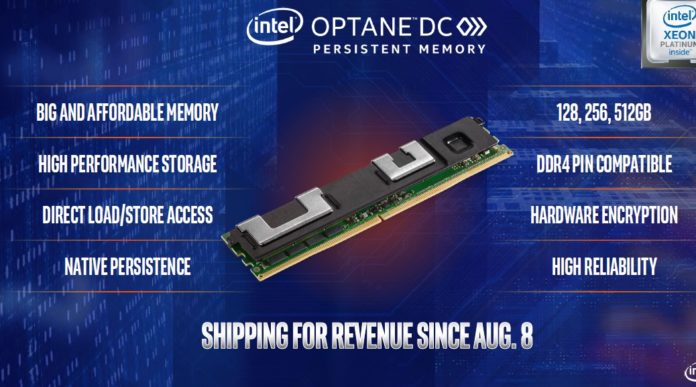Intel and SAP have signed a multi-year deal to boost SAP S/4HANA customer use of Optane DIMMs, more formally called Optane DC Persistent Memory.
The HANA in-memory database works faster with Optane DIMMs installed. For instance, a 6TB HANA instance takes four minutes to recover data after an outage, 12.5 times faster, compared with 50 minutes without Optane, the companies said.
Intel and SAP will optimise Intel’s Xeon SP processors and Optane DIMMs for SAP’s enterprise software, including HANA and S/4HANA, the Leonardo portfolio (AI, analytics, IoT, big data and blockchain) and SAP Business Suite applications.
A joint Intel-SAP centre of excellence will employ consultants to demo Xeon SP/Optane-boosted SAP software and discuss its use. The location for the demo centre was not announced at time of publication.
Separately, but no doubt intentionally, Red Hat today announced it has added RHEL support for Intel Optane in SAP environments.
Examining the Optane-assisted recovery
Intel and SAP said the Optane-assisted server recovers a 6TB SAP HANA data set 12.5 times faster than one without any Optane. But that server did not have anywhere near enough DRAM for the 6TB data set, making the comparison puzzling and seemingly invalid.
We can explain what is going on.
HANA is an in-memory database, meaning its data set resides in memory. If the base server had enough only memory to hold a fraction of the 6TB data set: first, where was the rest of the data set and, second; is it a valid comparison with an Optane-enhanced server that can hold the full dataset in memory?
A SAP document specifies the baseline and Optane server configurations involved in this HANA data set recovery test.
The baseline server configuration:
- Lenovo ThinkSystem SR950 server with 8 x Intel Xeon Platinum 8176M processors (28 cores, 165 watt, 2.1 GHz).
- 48 x 16GB TruDDR4 2,666 MHz RDIMMs – totalling 768GB DRAM.
- 5 x ThinkSystem 2.5-inch PM1633a 3.84TB capacity SAS 12 Gb hot swap SSDs for SAP HANA storage – totalling 19.2TB.
The operating system was SUSE Linux Enterprise Server 12 SP3 and uses SAP HANA 2.0 SPS 03 with a 6TB data set.
The recovery (restart) time was 50 minutes.
The Optane-assisted server was the same configuration and operating system but with 48 x 128 GB Intel Optane DC persistent memory modules (PMMs); a total of 6,144GB, added. The recovery time was then just four minutes.
Compression and tiering
There are two possible ways HANA can have a data set that is larger than the memory available: first, compression and second, through data tiering.
A SAP blog states: “SAP HANA could compress the data stored in the DW (Data Warehouse) by at least 3x. So, if your company chose to invest in HANA, your 9TB would be reduced to 3TB, and could even reach less than 1TB.”
However, there is no mention of compression in the SAP document referenced above.
SAP introduced a dynamic tiering feature with HANA SP9. That enabled HANA to store warm tables of data on spinning disks or SSDs, with only the hot data needed for fast analysis remaining in memory.
Recovering a HANA database from disk or SSDs involves reading it from the drives. When the data set can reside fully in memory it can be streamed in. When dynamic tiering is involved the dataset has to be read in and analysed with hot data identified for memory residency and warm data allocated to the external drives. This process takes longer than simply reading it into memory.
It took 50 minutes in the baseline system above.
Dataset fully in-memory
The SAP document says that with Optane DIMMs: “Data no longer needs to be reloaded from storage after a restart.” The Optane-assisted server configuration in the test did not need to do either dynamic tiering or even read-in from external drives. The data was already in the Optane DIMMs when the recovery test started.
Therefore initial recovery will obviously be much faster and subsequent analysis using warm data will also be faster as no data needs reading in from external drives or writing back. It is all in the Optane memory.
So…full dataset recovery from Optane persistent memory is many times faster than partial data set recovery from external drives to a small memory space and a far larger external drive storage tier. That’s great to know, but no real surprise.
Net: Net
Intel and SAP are touting Optane DIMMs as the way to get Xeon SP servers running SAP software faster and/or cheaper than DRAM-only servers and with much faster outage recovery.
There is no other SAP go-faster game in town inside the x86 server world so Intel should sell a deal of Optane DIMMery to SAP customers if the price/performance is right.
This may help stem the AMD and IBM Power server tide. And all other things being equal, SAP should sell more of its software against non-Optane-boosted competition such as Oracle.
Now read the Blocks & Files Optane DIMM explainer.








